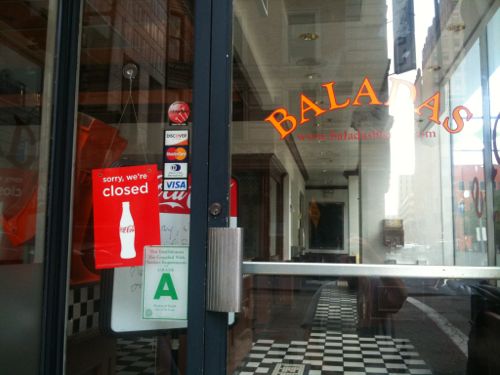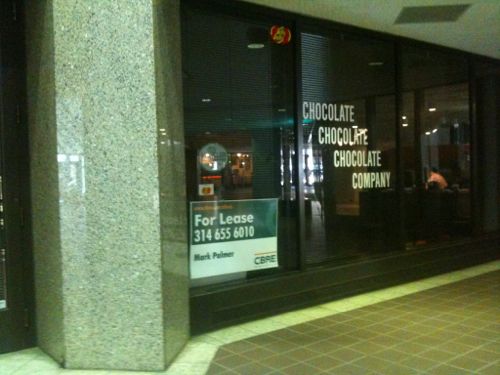AT&T Quietly Reduced Workforce In Downtown St. Louis
When most people see the AT&T office towers at 1010 Pine and 909 Chestnut St. they assume many people work there. The Pine tower is from 1925 and the Chestnut tower was built as the corporate headquarters of Southwestern Bell in 1985, both have just a fraction of the number of employees of even just 5 years ago.

Two issues: how AT&T reduced the workforce without public layoff notices and the implication for other downtown St. Louis businesses nearby.
Former and current employees tell the same story about how AT&T avoided having to issue layoff notices as required by the 1988 WARN Act. From one source:
AT&T has done a number of outsourcings since 2006-ish to different companies include Accenture, IBM and Amdocs. I was part of a 1,000 person division in IT which was outsourced to Amdocs in 2008.
We were given a very last minute notice about a mandatory meeting in February, 2008 in the Data Center auditorium where we were told we were being outsourced to Amdocs. Our pay & benefits (health insurance, vacation, etc.) were kept the same, with the exception of our pension as Amdocs did not have a pension plan. Instead, we were given an additional 5% match to our 401k. We still worked for the same boss (the outsourcing went up to the VP level, in my instance), at the same desk, doing the same work. The only difference is that our paycheck was coming from Amdocs.
In early February 2009, we received another mandatory meeting invite for the employees in my group. In the data center auditorium, an Amdocs manager (from a different division, located in Champaign, who none of us had ever met) read a prepared statement stating that layoffs were necessary because the amount of work assigned to our group was falling short of what was anticipated at the time of the outsourcing. We should return to our desks and those employees being let go would receive an email while those not being let go would not. About an hour later, I received an email indicating I would be laid off on February 26, 2009. Approximately 500 of the 1000 people in my group were laid off in total.
The significance of that date? It was one year and one day after we had been outsourced to Amdocs. The contract between Amdocs and AT&T specified any employees laid off in the year following the outsourcing would be given severance at the AT&T rate (4% of salary per year of employment). After that date, severance would be paid at the Amdocs rate (1 week per year of employment). To rub salt in the wound, our final paychecks contained pay for 72 hours as we were let go on a Thursday and worked only 9 days out of the 10 day pay period (rather than the usual 86 2/3rs hours as salaried employees).
My source indicated Amdocs issued WARN Act notices in California, where they have stricter requirements, but AT&T and contractors avoided having to announce reductions in St. Louis.
In August 2009 our downtown grocer, Culinaria, opened for business. A year later businesses on the one block of 9th between AT&T and Culinaria were closing due to lack of customers. Culinaria was blamed but one person I spoke with says this was the height of the reductions.


To make matters worse for nearby businesses, many of the remaining employees telecommute from home rather than come into the office. Reduced property taxes is another issue:
Inland’s affiliate, MB St. Louis, convinced St. Louis assessor Ed Bushmeyer that the AT&T tower is now worth just $135 million – about $70 million less than what it sold for in 2006.
Jerome Wallach, an attorney for MB St. Louis, argues that the building’s value plummeted because AT&T has slashed the size of its workforce there, and low occupancy cuts the building’s market value. The owner would have difficulty selling the half-full building for an attractive price when AT&T’s lease expires in 2017, he added.
But the building is not for sale now, Wallach acknowledged, nor has MB St. Louis given AT&T any rent breaks on the property because of its diminished presence. Wallach argues the rent shouldn’t factor into assessed value, which should be based on what it might sell for now in its half-full state. (stltoday.com from April 2012)
No doubt AT&T plans to completely vacate the 909 Chestnut building after their lease expires, in the meantime the numbers of employees at both buildings will continue to dwindle.
— Steve Patterson
I worked there from 2003 – 2007 in One Bell Center (909 Chestnut St) and I’ve never worked at a place where so many people were doing so little. I worked in the Middleware Services team in IT and it seemed that 50%+ of the developers sat around and did almost no work. The management would invent complex procedures and documentation requirements to rationalize having so many people and to fill the time of the redundant employees. The average employee spent about 80% of his/her day attending meetings that weren’t relevant to them but they were *required* to attend. As best as I could tell, the managers just wanted to have “lots of people under them” in their little empires to make themselves important and to keep their budgets high. I guess this couldn’t last forever!
What I’m sad about is
1) this will be a blow to downtown when downtown’s comeback has long since stalled.
2) that even fewer middle class white collar jobs are available in the city. It seems that a majority of office work (especially IT) has moved out to the 270 corridor between Manchester and Page. This is largely to make it more convenient for the executives to drive from Ladue/Town & Country/etc and for the middle class office workers to commute from west county and St. Charles.
While I share your disappointment, I’m not quite sure why you’re focusing on one company. AT&T apparently dotted all their i’s and crossed all their t’s to minimize both publicity and liability, but they’re far from the only company to downsize during the recession (leaving vacant office space and impacting adjacent service businesses – at least they’re still honoring the terms of their leases). Plus, their business model has changed, drastically, as mobile technology has matured. The recession negatively impacted most businesses and resulted in many employee layoffs. Yeah, it sucks if you’re one of those employees (as I was), but it’s “just business”. If the revenues aren’t there to pay the employees, there aren’t a lot of other options.
As for the (or any) building’s value on the open market (which is what any assessment should accurately reflect), yes, rents have a direct impact. Buyers factor in rent rolls, and do look at when leases expire and how likely a tenant is to renew (that’s why commercial landlords would rather offer several months of “free” rent than to offer a lower overall rate). Any 2006 value would be substantially higher than it would sell for today, and with it more than “half vacant”, any buyer will have to do some serious marketing and plan on paying for substantial tenant improvement costs for any new tenants they capture.
Bottom line, for better or worse, this is what the free market looks like. When times are good, there are more “winners”. When times are bad, there are more “losers”. There are no guarantees, either way. AT&T (and its employees) had a good run as a land line company, especially when it had a monopoly, but the world is evolving. If you’d be happy living in a world without G4 and iphones, then we’d still have a lot more AT&T employees. Instead, the growth is happening in Cupertino and China, and not here . . . .
The rent for 909 Chestnut is still 100% until AT&T’s lease expires in 2017. Yes, many companies have had layoffs and the large ones announced them as required by law rather than using loopholes to avoid large scale reductions in employees.
While you may feel that what AT&T did was somehow (morally?) wrong, apparently it was not “required by law”, otherwise they’d be in court. In reality, it’s not much different than what auto companies have done, subcontracting out and spinning off many parts of their production processes, nor is it much different than what small employers do every day. When was the last time you saw any announcements about design firms making substantial reductions in staff? 30%+ unemployment for architects speaks for itself! And from today’s Denver Post, “Layoffs, failures test Colorado’s ‘new energy economy'” http://www.denverpost.com/business/ci_21825181/layoffs-failures-test-colorados-new-energy-economy
I agree with JZ…this is the free market. Why just ATT? Look down the road at AB. I know it’s a sad day and leaves a tragic wake when employees are laid off. But that is today’s economic reality. It’s harsh but it’s true. Employer Loyalty to workers went away years ago. That’s the first issue you address Steve.
As for the second issue…there are two types of managers….those that do, and those that don’t. Those that do adapt, find ways to build a repeat customer base, branch out to other lines/offerings, etc. Those that don’t sit around, bitch and complain that the customers ‘they deserve’ don’t come to them.
What comes to mind are two restaruants…both made the news….one complained on their closing day that the highway 40 re-build destroyed their customer base (while ignoring the fact that they were in South City 5 miles from the nearest highway access)…the other recently in the news because for 6 months their business decreased in Webster while they rebuilt the Murdoch bridge. Both of these incidents came with plenty of notice to the business owners….but it’s up to the buisness owner to stay relevant and adapt/change.
So what does this mean? If those nearby small business owners are relying just on AT &T customers, without reading the writing on the wall….then maybe they need to fail. Or maybe they can take some pointers from their neighbors to the south that adapted, changed, and survived when AB dumped staff.
I recently posted about AT&T’s data center building and this is a related post, not intended to cover every corporation that skillfully uses employment loopholes.
Job protection legislation has been enacted for good reason. Recent history teaches us that corporations cannot and will not self regulate. I sense in some of these comments a “47 percent” attitude — implying that those who have lost their jobs, or who are struggling to keep their small business afloat, somehow deserve their plight for not trying hard enough to succeed. I am well versed in economic policy — and the oft-cited philosophy of Milton Friedman — and unfortunately, a pure supply side/free market approach will lead us into an economic abyss. Exploitation of a loophole may be legal, but it does not make it the right thing to do.
As both a laid-off employee and a former small business owner, I think I can see both sides. Bottom line is the bottom line – if business falls off, for whatever reason (economy, technology, clients, competition), there will be less money to pay employees, period. The choices are few – fewer employees, fewer hours and/or less pay – money doesn’t grow on trees. Delaying the inevitable may seem like a “win” in the short run, but it doesn’t make it any easier to sustain the shrinking employer nor does it make it any easier for the former employee to look for a new position – it still sucks! The best job “protection” remains staying relevant!
If one can use history as a guide, the sad story of East St. Louis offers a very clear parallel. Industrial corporations, in an attempt to avoid regulation and taxation, incorporated company towns in which they had free reign — exploiting the services of adjacent East St Louis while returning nothing in taxes. When those corporations exited the region, for whatever reason, they left a decimated city without a sustainable tax base and surrounded by toxic “brown fields”.
I got that Steve but my point was that it is up to the business to keep eyes and ears open. And well there may be no ‘official’ notice given…the employees know well in advance that at the very least…change is in the air. So if they overhear employees in the dry cleaner line (or whatever line it is), then they should engage them and find out more. It never hurts to know more than needed.
Putting moral, ethical, and political issues aside — the bottom line is that AT&T’s mass exodus from downtown after 120 years (the original Bell Telephone headquarters was at 920 Olive, built in 1889) is devastating to surrounding retail operations, and to the city’s tax base. Coupled with the exodus of May Company, Edison Brothers, and other major employers, the dynamic of downtown has fundamentally (and irreparably?) changed. The streets are noticeably less busy at the noontime hour, and restaurants counting on daytime traffic face an ever increasing struggle to stay alive. On the other hand, restaurants and businesses catering to nighttime business appear to be doing well. This is a 180 turn from even 10 years ago.
In a larger sense, this post illustrates a fundamental shift in the US economy. The core employment in these buildings has been Information Technology since Southwestern Bell moved its headquarters to Texas in the 1990s. Outsourcing — onshore and offshore — has had a huge toll on employment opportunities in IT. According to the Brookings Institute, the St. Louis metropolitan area lost a staggering 8.9% of its IT employment base in the past twelve months alone. Bombastic statements about training unemployed or underemployed Americans for the “new economy” is empty political rhetoric.
I was an employee at Southwestern Bell/SBC/AT&T, working at OBC, from the mid-90’s until 2007 and suffered a similar fate. I was outsourced to IBM and became an IBM employee doing the same job (with a group of two or three hundred being sent to IBM– probably 100 or so of those affected were based in St. Louis). Six months later, we were told our positions were being migrated offshore and we needed to teach our replacement workers in India. I left mid 2009 after everyone else in my group was laid off and now work in Maryland Heights.
I miss working downtown, walking around at lunch, and taking the bus/metro to work. A two hour commute via Metrobus is not a reasonable possibility so I’m forced into an auto-centric life. It would be great to work in the city again but that would require more software businesses to relocate downtown.
Serious question. Could these turn into condos? Well I mean 1001 seems perfect. 909 maybe not.
AT&T sold 909 a few years ago but kept the smaller building at 10 & Pine so that tells me they plan to consolidate into their older building by the time the lease on 909 expires. No, I don’t think it would be good for residential use since it has fixed windows.
1010 Pine was a beautiful building, lots of marble, brass, hardwood, etc. It was almost entirely empty when I worked there a few years ago.
Interesting idea….windows can be replaced. Wasn’t the Pet building fixed windows too? I think one thing we can sadly bet on is it won’t be a fortune 500 company…so what do we have around that could use it? And how will the City lure them?
While I like the idea of creative reuse, what we really need is more employers and more jobs downtown – we simply can’t convert every vacant office or industrial building into residential lofts and expect to have a thriving economy and/or a vibrant, urban downtown area.
Agreed, this can go from being a corporate HQ building to a multi-tenant building. Hopefully the first floor can be made more inviting.
[…] * This is how job losses are covered up. […]
Yup….my division at SBC/AT&T (One Bell Center) was in this boat. Only difference is I left before that final nail was put in the coffin. I live downtown and you can see the impact these vacancies have on the community. Sucks…but what can ya do?